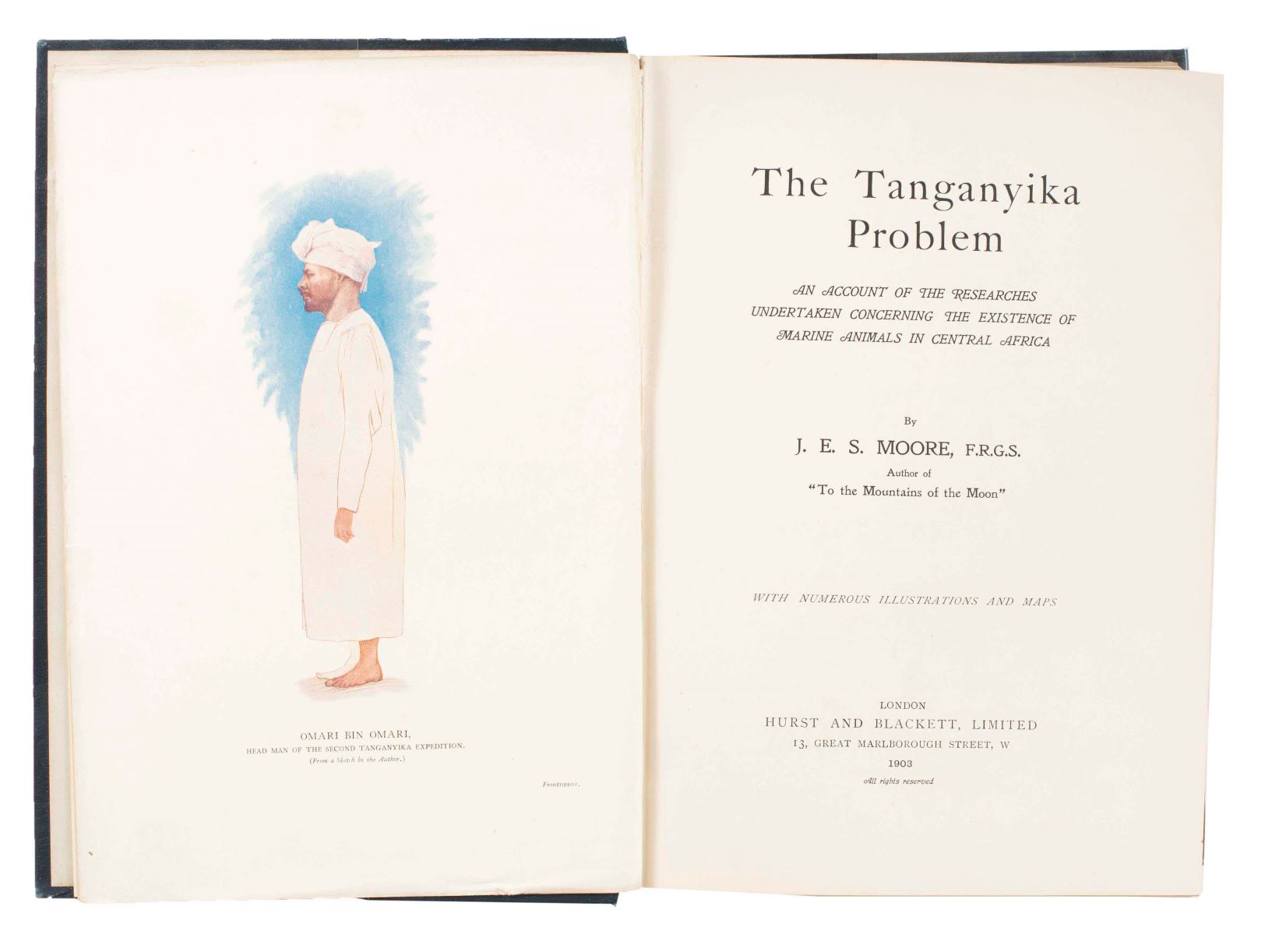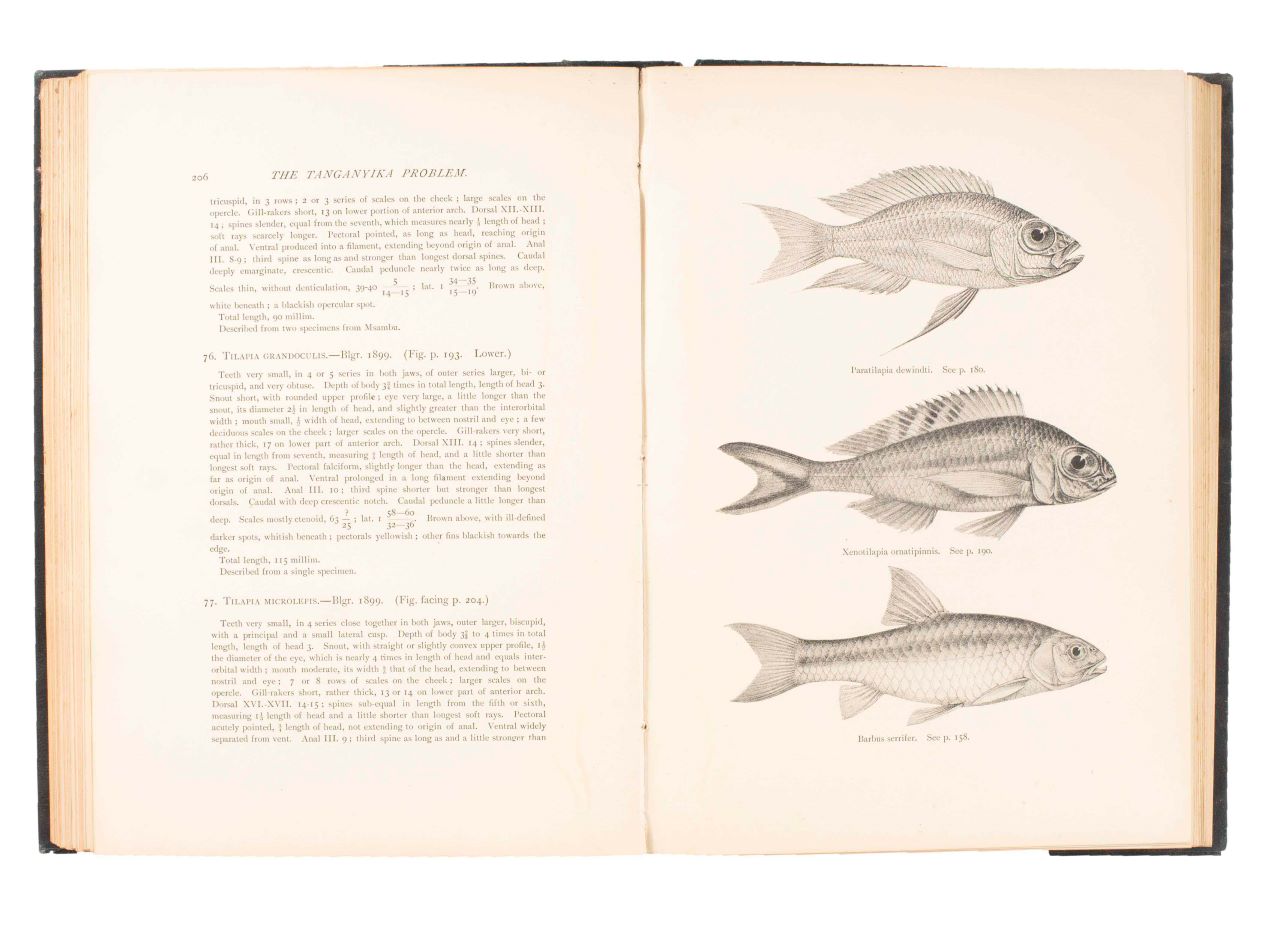


Jurassic Lake
MOORE, John Edward Sharrock.
The Tanganyika Problem: an account of the researches undertaken concerning the existence of marine animals in Central Africa.
London, Hurst and Blackett, 1903.
8vo, pp. xxiii, [1], 371, [5 (publisher’s catalogue)]; with 3 monochrome maps, 4 folding coloured maps, 12 coloured plates, 50 monochrome plates, 5 folding plates, and more than 70 illustrations in the text; browning to half-title and very occasional light foxing in margins; an excellent copy in publisher’s dark blue textured cloth with gilt vignette and lettering on upper cover, gilt lettering on spine; slight wear to extremities, a few spots to covers.

Added to your basket:
The Tanganyika Problem: an account of the researches undertaken concerning the existence of marine animals in Central Africa.
First edition, copiously and beautifully illustrated, of J.E.S. Moore’s survey of the marine fauna of Lake Tanganyika in Central Africa, ‘the first definite account of the Zoology and the Geology of the Great Lake Region of Africa, and of the extraordinary chain of evidence which has led to the belief that Tanganyika represents the old Jurassic Sea’.
The so-called ‘Tanganyika problem’ began with its discovery by explorers Richard Burton and John Hanning Speke in 1858: Speke had collected a number of shells from the area which, when examined in the British Museum, were revealed to be distinct from other known fresh-water forms. Between 1896 and 1900, the geologist and marine biologist J.E.S. Moore set out on two Tanganyika expeditions seeking to explain these peculiarities, firstly by surveying the marine animals of Lake Tanganyika itself, and secondly by comparing his findings with the fauna of nearby Lake Kivu, Lake Edward, and Lake Albert. Moore concluded that the fauna of Tanganyika was not comparable with other living marine forms, but instead seemed to hail from an earlier stage of marine evolution. As a result, he argued that Tanganyika, unlike the other great African lakes, must once have been connected to the sea, from whence came its peculiar marine species: ‘The strange animals, the jelly-fishes, the molluscs, the sponges etc., which appear in Tanganyika, and apparently nowhere else in Africa now, may be regarded as the relic of a time when the lake basin was in connection with an ancient sea, and consequently filled with its ancient fauna. Moreover, the date of the lake’s connection with the sea, which this view of the nature and origin of the halolimnic fauna necessitates, is so remote, that it can easily be made to fit in with our revised notions of the past history of the continent’ (p. 6).
Moore published his first work on the subject, To the Mountains of the Moon, in 1901. The work detailed the events of his second Tanganyika expedition, northwards of the lake through modern day Rwanda, Uganda, and the Democratic Republic of Congo. Although he already advanced many of the conclusions he was to expand upon later, the work was intended for a general audience and focusses on the narrative and adventure of his expedition rather the quality and impact of his findings. This work, of which the present copy is the first and only edition, was first published in 1903 and is far more scientific in content. It begins with a description of the Tanganyika problem as Moore sees it, and then goes on to describe in detail the geology and marine biology of the lake. This includes numerous illustrations and plates of the various fish, mollusc, and crustacean varieties which Moore studied in Tanganyika and brought back to the British Museum. Consequently, Moore’s work stands tall both as an important work of natural history and marine biology and as a visually arresting and impressive work of geological and marine illustrations.

